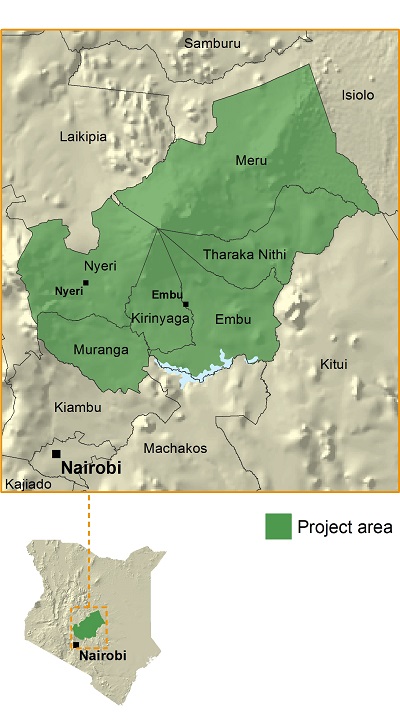Upper Tana Catchment Natural Resources Management Project
IFAD Asset Request Portlet
ناشر الأصول
Upper Tana Catchment Natural Resource Management Project
The goal of this project is to contribute to the reduction of rural poverty in the Upper Tana River catchment through increased sustainable food production and incomes for poor rural households, as well as sustainable management of natural resources.
The project has three main components:
- Empowering communities to sustainably manage natural resources by building their capacity to develop resource management plans while also improving their livelihoods
- Sustainably improving the incomes and living standards of the target group through interventions that are beneficial to the management of the natural resource base
- Improving the sustainable management and use of water and other natural resources.
The target area for the project is the Upper Tana catchment, covering 6 of Kenya's 47 counties. Around 205,000 poor rural households – including smallholder crop and livestock farmers, agro-pastoralists, fishers and rural traders – are expected to benefit from the initiative, which features a special focus on women, young people and other vulnerable groups.
Source: IFAD

تقارير الرئيس
تقرير تصميم المشروعات
وثائق دعم الإشراف والتنفيذ
وثائق دعم الإشراف والتنفيذ
الاسيت ببليشر
الاسيت ببليشر
الاسيت ببليشر
الاسيت ببليشر
Mid-term review mission, June 2017
الاسيت ببليشر
الاسيت ببليشر
الاسيت ببليشر
الاسيت ببليشر
الاسيت ببليشر
الاسيت ببليشر
الاسيت ببليشر
الاسيت ببليشر
Related Contents
Related Contents
طاقة نظيفة، مجتمعات ريفية مزدهرة
في عالم يزداد سخونة بشكل متسارع، يعد الانتقال السريع نحو الطاقة النظيفة أمرا بالغ الأهمية. ولكي نتجنب أسوأ آثار تغير المناخ، يجب علينا تحقيق معيارين رئيسيين: خفض انبعاثات غاز الدفيئة إلى النصف بحلول عام 2030 وتحقيق صافي الانبعاثات الصفري بحلول عام 2050.
مستقبل للطلاب زاخر بالماء والخضراوات والورود
في مقاطعة نييري في كينيا، حسنت تقنيات أنظمة المياه المستدامة بشكل كبير من حياة الطلاب والموظفين والمجتمعات المحيطة وفتحت مستقبلًا أكثر إشراقًا للكثيرين.
البناء من أجل التنوّع البيولوجي: كيف قام سياج واحد بحماية المزارعين والمحاصيل- والحياة البرية في كينيا
غالبًا ما نعتبر الفِيلَة من العمالقة اللطيفة. وهي تنال حبّ عشّاق الطبيعة في كل أصقاع العالم، كما تشكّل سمةً أيقونية للغابات والمروج في أفريقيا وآسيا. كما تشكّل أيضًا من الأنواع الأصيلة التي لا غنى عنها من أجل الحفاظ على التنوّع البيولوجي للنظم الإيكولوجية التي تعيش فيها.